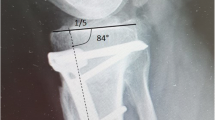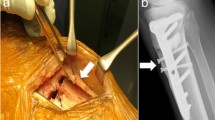Abstract
Purpose
To investigate risk factors and suggest preventive strategy for excessive coronal inclination of tibial plateau following medial opening-wedge high tibial osteotomy (MOWHTO).
Methods
A total of 133 consecutive patients who underwent MOWHTO were retrospectively enrolled. Patients were divided into two groups based on postoperative medial proximal tibial angle (post-MPTA) of 95°: control group (n = 111, 83.5%) with post-MPTA less than 95° and excessive MPTA group (n = 22, 16.5%) with post-MPTA 95° or more. Demographics, radiographic parameters [mechanical lateral distal femoral angle (mLDFA), MPTA, posterior tibial slope, joint line obliquity (JLO), hip-knee-ankle angle, joint line convergence angle (JLCA), weight bearing line ratio, and correction angle], and clinical outcomes of patients were compared. Multiple logistic regression analysis was performed to determine risk factors for post-MPTA 95° or more.
Results
Multiple logistic regression analysis showed that preoperative JLO ≥ 3° [odds ratio (OR) 6.940, 95% confidence interval (CI) 2.373–20.296, p < 0.001] and preoperative JLCA ≥ 5° (OR 5.723, 95% CI 1.833–17.865, p = 0.008) were statistically significant risk factors for post-MPTA ≥ 95°. Incidences of excessive MPTA following MOWHTO in patients with none, one, and two risk factors preoperatively were 3.7%, 26.7%, and 77.8%, respectively.
Conclusion
Preoperative JLO ≥ 3° and JLCA ≥ 5° were two significant risk factors for excessive MPTA following MOWHTO. Thus, surgeon should consider other types of osteotomy if these two risk factors are present together preoperatively in MOWHTO candidates.
Level of evidence
Level III.




Similar content being viewed by others
References
Laprade RF, Spiridonov SI, Nystrom LM, Jansson KS (2012) Prospective outcomes of young and middle-aged adults with medial compartment osteoarthritis treated with a proximal tibial opening wedge osteotomy. Arthroscopy 28(3):354–364. https://doi.org/10.1016/j.arthro.2011.08.310
Schuster P, Schulz M, Mayer P, Schlumberger M, Immendoerfer M, Richter J (2015) Open-wedge high tibial osteotomy and combined abrasion/microfracture in severe medial osteoarthritis and varus malalignment: 5-year results and arthroscopic findings after 2 years. Arthroscopy 31(7):1279–1288. https://doi.org/10.1016/j.arthro.2015.02.010
Agneskirchner JD, Freiling D, Hurschler C, Lobenhoffer P (2006) Primary stability of four different implants for opening wedge high tibial osteotomy. Knee Surg Sports Traumatol Arthrosc 14(3):291–300. https://doi.org/10.1007/s00167-005-0690-1
Kohn L, Sauerschnig M, Iskansar S, Lorenz S, Meidinger G, Imhoff AB, Hinterwimmer S (2013) Age does not influence the clinical outcome after high tibial osteotomy. Knee Surg Sports Traumatol Arthrosc 21(1):146–151. https://doi.org/10.1007/s00167-012-2016-4
Na YG, Lee BK, Hwang DH, Choi ES, Sim JA (2018) Can osteoarthritic patients with mild varus deformity be indicated for high tibial osteotomy? Knee 25(5):856–865. https://doi.org/10.1016/j.knee.2018.05.001
Akamatsu Y, Kumagai K, Kobayashi H, Tsuji M, Saito T (2018) Effect of increased coronal inclination of the tibial plateau after opening-wedge high tibial osteotomy. Arthroscopy 34(7):2158–2169. https://doi.org/10.1016/j.arthro.2018.01.055 (e2152)
Nakayama H, Schroter S, Yamamoto C, Iseki T, Kanto R, Kurosaka K, Kambara S, Yoshiya S, Higa M (2018) Large correction in opening wedge high tibial osteotomy with resultant joint-line obliquity induces excessive shear stress on the articular cartilage. Knee Surg Sports Traumatol Arthrosc 26(6):1873–1878. https://doi.org/10.1007/s00167-017-4680-x
Babis GC, An KN, Chao EY, Rand JA, Sim FH (2002) Double level osteotomy of the knee: a method to retain joint-line obliquity. Clinical results. J Bone Jt Surg Am 84(8):1380–1388. https://doi.org/10.2106/00004623-200208000-00013
Oh KJ, Ko YB, Bae JH, Yoon ST, Kim JG (2016) Analysis of knee joint line obliquity after high tibial osteotomy. J Knee Surg 29(8):649–657. https://doi.org/10.1055/s-0036-1571430
Saragaglia D, Mercier N, Colle PE (2010) Computer-assisted osteotomies for genu varum deformity: which osteotomy for which varus? Int Orthop 34(2):185–190. https://doi.org/10.1007/s00264-009-0757-6
Saragaglia D, Nemer C, Colle PE (2008) Computer-assisted double level osteotomy for severe genu varum. Sports Med Arthrosc Rev 16(2):91–96. https://doi.org/10.1097/JSA.0b013e318172b562
Koh IJ, Kim MS, Sohn S, Song KY, Choi NY, Jung H, In Y (2019) Predictive factors for satisfaction after contemporary unicompartmental knee arthroplasty and high tibial osteotomy in isolated medial femorotibial osteoarthritis. Orthop Traumatol Surg Res 105(1):77–83. https://doi.org/10.1016/j.otsr.2018.11.001
Schroter S, Nakayama H, Yoshiya S, Stockle U, Ateschrang A, Gruhn J (2019) Development of the double level osteotomy in severe varus osteoarthritis showed good outcome by preventing oblique joint line. Arch Orthop Trauma Surg 139(4):519–527. https://doi.org/10.1007/s00402-018-3068-9
Kim MS, Son JM, Koh IJ, Bahk JH, In Y (2017) Intraoperative adjustment of alignment under valgus stress reduces outliers in patients undergoing medial opening-wedge high tibial osteotomy. Arch Orthop Trauma Surg 137(8):1035–1045. https://doi.org/10.1007/s00402-017-2729-4
Han SB, Lee DH, Shetty GM, Chae DJ, Song JG, Nha KW (2013) A “safe zone” in medial open-wedge high tibia osteotomy to prevent lateral cortex fracture. Knee Surg Sports Traumatol Arthrosc 21(1):90–95. https://doi.org/10.1007/s00167-011-1706-7
Coventry MB (1987) Proximal tibial varus osteotomy for osteoarthritis of the lateral compartment of the knee. J Bone Jt Surg Am 69(1):32–38
Bellemans J, Vandenneucker H, Vanlauwe J, Victor J (2010) The influence of coronal plane deformity on mediolateral ligament status: an observational study in varus knees. Knee Surg Sports Traumatol Arthrosc 18(2):152–156. https://doi.org/10.1007/s00167-009-0903-0
Sharma L, Lou C, Felson DT, Dunlop DD, Kirwan-Mellis G, Hayes KW, Weinrach D, Buchanan TS (1999) Laxity in healthy and osteoarthritic knees. Arthritis Rheum 42(5):861–870. https://doi.org/10.1002/1529-0131(199905)42:5%3c861::Aid-anr4%3e3.0.Co;2-n
Lee DH, Park SC, Park HJ, Han SB (2016) Effect of soft tissue laxity of the knee joint on limb alignment correction in open-wedge high tibial osteotomy. Knee Surg Sports Traumatol Arthrosc 24(12):3704–3712. https://doi.org/10.1007/s00167-015-3682-9
Kumagai K, Yamada S, Akamatsu T, Nejima S, Ogino T, Sotozawa M, Inaba Y (2020) Intraoperatively accurate limb alignment after opening wedge high tibial osteotomy can be lost by large knee joint line convergence angle during surgery. Arch Orthop Trauma Surg. https://doi.org/10.1007/s00402-020-03419-1
Ji W, Luo C, Zhan Y, Xie X, He Q, Zhang B (2019) A residual intra-articular varus after medial opening wedge high tibial osteotomy (HTO) for varus osteoarthritis of the knee. Arch Orthop Trauma Surg 139(6):743–750. https://doi.org/10.1007/s00402-018-03104-4
Sim JA, Kwak JH, Yang SH, Choi ES, Lee BK (2010) Effect of weight-bearing on the alignment after open wedge high tibial osteotomy. Knee Surg Sports Traumatol Arthrosc 18(7):874–878. https://doi.org/10.1007/s00167-009-1000-0
Tsuji M, Akamatsu Y, Kobayashi H, Mitsugi N, Inaba Y, Saito T (2020) Joint line convergence angle predicts outliers of coronal alignment in navigated open-wedge high tibial osteotomy. Arch Orthop Trauma Surg 140(6):707–715. https://doi.org/10.1007/s00402-019-03245-0
Kim CW, Seo SS, Lee CR, Gwak HC, Kim JH, Jung SG (2017) Factors affecting articular cartilage repair after open-wedge high tibial osteotomy. Knee 24(5):1099–1107. https://doi.org/10.1016/j.knee.2017.06.001
Funding
No funding was received for this study.
Author information
Authors and Affiliations
Corresponding author
Ethics declarations
Conflict of interest
All authors of this study declare that there is no conflict of interest relevant to this study.
Ethical approval
All procedures performed in studies involving human participants were in accordance with ethical standards of the institutional and/or national research committee, the 1964 Helsinki Declaration, and its later amendments or comparable ethical standards. This study was approved by IRB of Seoul St. Mary’s Hospital, the Catholic University of Korea (Study No.: KC17REDI0368).
Informed consent
Informed consent was obtained from all individual participants included in this study.
Additional information
Publisher's Note
Springer Nature remains neutral with regard to jurisdictional claims in published maps and institutional affiliations.
Rights and permissions
About this article
Cite this article
Sohn, S., Koh, I.J., Kim, M.S. et al. Risk factors and preventive strategy for excessive coronal inclination of tibial plateau following medial opening-wedge high tibial osteotomy. Arch Orthop Trauma Surg 142, 561–569 (2022). https://doi.org/10.1007/s00402-020-03660-8
Received:
Accepted:
Published:
Issue Date:
DOI: https://doi.org/10.1007/s00402-020-03660-8




